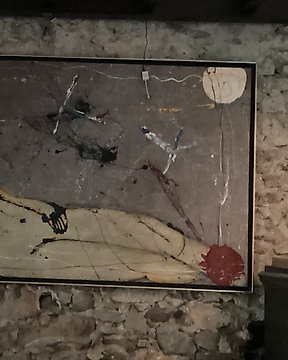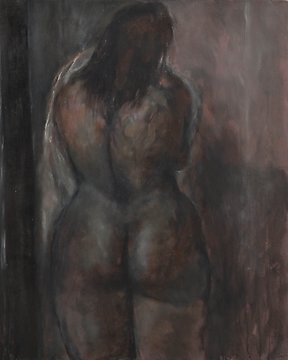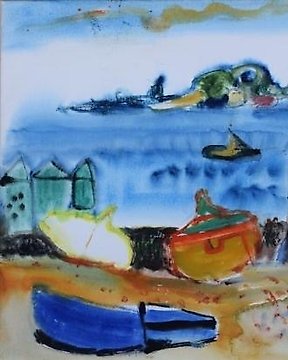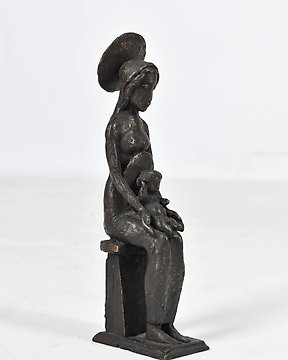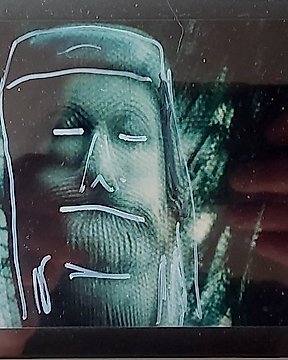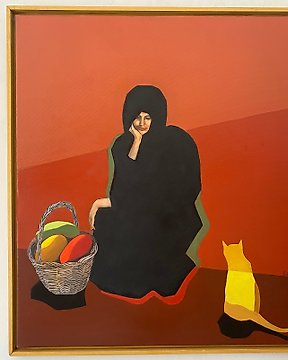Ronald Manullang (1954) - The Annunciation
Αρ. 43132825

Jan van Gent (Jef van Tuerenhout) - Havenzicht
Αρ. 43132825

Jan van Gent (Jef van Tuerenhout) - Havenzicht
Jef van Tuerenhout (Mechelen, Belgium 1926-2006), a.k.a. "Jan Van Gent".
Large painting of the Vistrap in Ostend, painted in the late 1940s-early 1950s. In the lower left signed with "J. Van Gent" (alias for Jef van Tuerenhout early in his artistic career).
Jef van Tuerenhout spent his youth in Mechelen. He studied painting and sculpture at the St-Lucas Academy in Brussels during World War II. He was awarded the honorary award of the Academy. From his year, only two artists have become professional painters: he and Armand Minner. He himself admitted that he had learned little or nothing at the academy and hardly knew the difference in use between turpentine and white spirit.
From the beginning he resolutely opted for painting as a profession. Teaching at an academy he considered pure loss of time. He, as an individualist, did not want to make commercial compromises at this point. During this period he painted expressionist works with many grisaille tones, reminiscent of the works of Constant Permeke. They depict a terse and closed mental world, obscured by war experiences and riddled with a bleak sense of fear.
He drew his first works using the pseudonym "Jan van Gent". These were various subjects, such as St. Maria, Duinenzicht or a Spanish street.
But already as a young artist he was able to break free from the Flemish-expressionist approach. The abstract could no longer captivate him. He thought this was too regional. It limited him to a previous period. From now on, he chose to paint figuratively in his own, recognisable visual language. At first he worked by model, but soon stopped, because he then acquired a central figure with a background. That build-up of the composition bothered him. In 1949 he participated in the group exhibition "Contemporary Painting in Belgium", together with some other painters who also strived for an innovative, modern and contemporary art creation: Pol Mara, Paul van Hoeydonck, Jan Cox and Gaston Bertrand. Together with Jan Vaerten, Rudolf Meerbergen and Jan Cox he worked on the magazine "Tijd en Mens" (1949-1955), led by Jan Walravens (1920-1965) as the theorist of the Tijd en Mens-generation. He gave his first solo exhibition in Mechelen in 1950 and in 1951 he also showed some works at the exhibition, organised by "Tijd en Mens".
He moved to Antwerp in 1952 and lived in attics, wandering from house to house. He was commissioned for a monumental mural in the "Boomse Metaalwerken" (a company that closed its doors in 1998).
By chance he came to live in Ostend. When he was camping in Bredene in 1954, he happened to meet a friend in Ostend who was moving. He could take over his studio. Van Tuerenhout started a small art gallery there. Later he moved to a belle-époque house on the Zeedijk of Ostend. In this house, he and his wife, Clara Raes, would spend most of their lives. He found himself in the anarchist Ostend artist world, centred around the night owls and the bohemians in the Ostend pub "La Chèvre Folle" (Etienne Elias, Yves Rhayé, Willy Bosschem, Roland Devolder, Hubert Minnebo, Lismonde, blues guitarist Roland...). He has also held a number of exhibitions in this pub – and sold works. In 1967, together with a German artist, he held a happening against the Berlin Wall. The police got involved.
Poster of the group exhibition Ensor, Permeke, Spilliaert (1955) by Willy Bosschem.
In 1955 he participated in the group exhibition "Ensor, Permeke, Spilliaert and contemporary painting" in Ostend. From now on, one exhibition after another followed, both nationally and internationally. Already in 1957 two paintings were purchased by the Quaker Storage Co collection from Philadelphia (USA). He first showed graphics and sculpture at his exhibition in Brussels in 1966. His first lithograph was published in 1969.
From 1966 onwards, his style evolved and left the miserabilist-expressionist style. He created a new, meticulously worked-out world, with a charming but dominant woman as a muse. He would now focus almost exclusively on the representation of the mystical in the woman, rendered with an exotic, refined and complex colour scheme, bathing in light and darkness, in a sensual, magical-realistic style. Like Paul Delvaux and Félix Labisse, he gradually created his own female archetype, recurring in his works: stately, unapproachable, irresistible, enigmatic, intriguing, attractive, refined and sensual. From now on he evolved within these sensual beacons, increasingly perfectionist and with a fine sense of colour harmony. He consciously portrays his partially naked female figures stretched out with skinny, elongated hands. He calls this "verticalism". They also often wear an iron tube around the neck and majestic hats. These elements also contribute to the verticalism of the figure.
His first anthropomorphic creatures were half sphinx-half sibyl with another influence of Flemish expressionism. These creatures live in a quiet, petrified world surrounded by an atmosphere of sultry sensuality.
His paintings and graphics were full of restrained eroticism. They contain all kinds of magical signs and fetishistic attributes (egg = fertility; bird = freedom; skeletons = duality of life and death) or the animalism of cats, tigers or large birds of prey. Inspired by African, Asian and Polynesian sculptures, he gave his archetype the look of these primitive sculptures: rowdy, untouchable priestesses with elongated necks and oval face, exotic hairstyles, covered with eagle heads, devil shores or variegated halos. His works also reflected his fascination with felines, panthers or lions (he even had a lion as a pet for a while) whose movements are as smooth and graceful as his wives.
All this gave an individual style to his works, which, at a glance, are immediately recognisable for everyone. In his works he often gave a nod to other artists by taking over elements from their works: the monstrous heads of Yves Rhayé (1936-1995), (as in his work "De Loerders") or the flower hat of James Ensor (as in his well-known work "Hello James", made in protest against the theft of the self-portrait of James Ensor) or again James Ensor with "De Intocht van Jef van Tuerenhout in Oostende" on the occasion of the Ensor-year 1985.
He was also a designer of jewellery in gold, silver and diamonds. He gave his first exhibition in 1971.
Both the then O.R.T.F. (French television) in 1971 and the BRT (Flemish television) in 1972 made a television portrait of him. In 1976 R. Claeys made the film "Portret van Jef van Tuerenhout".
In his long artistic career he received several retrospectives: in 1974 (Casino, Ostend), 1975, 1986 and 2001 (Cultural Centre Antoon Spinoy, Mechelen), 2005 (in the Italian artist city Pietrasanta, near Pisa), March 2006 (Cultural Centre, Aarschot), summer 2006 (Blankenberge). In the last decades of his life he received a broad international recognition.
During all his foreign exhibitions he came into regular contact with well-known artists, many of whom he could count among his personal friends: Salvador Dalí, Corneille, Karel Appel, César, Max Ernst, Fuchs, Paul Delvaux; but also with a lot of famous singers and movie stars: Jacques Brel, Maurice Chevalier, Michèle Morgan
He became a Knight of the Order of Leopold II in 1976. He was also an ambassador for UNICEF. The proceeds of his painting for the poster of the Memorial Van Damme in 2003 were donated to a project in Morocco.
He moved to Wenduine in 1993 in a quietly renovated old monastery, where Soeur Sourire once lived.
He died of a lingering illness on 4 March 2006 in his home town of Wenduine.
His works are mainly still in private collections, but also in museums at home and abroad.
He was an individualist, isolated figure who could hardly be counted to any specific art movement. In this he is reminiscent of Leonor Fini and Fernando Botero.
Width 150 cm, height 125 cm.
In good condition, to be picked up in Sint Amandsberg near Ghent.
Μπορεί επίσης να σας αρέσει
- 16+
Αυτό το αντικείμενο παρουσιάστηκε στο
Πώς να πραγματοποιήσετε αγορές στην Catawiki
1. Ανακαλύψτε κάτι ιδιαίτερο
2. Υποβάλετε την κορυφαία προσφορά
3. Πληρώστε με ασφάλεια

